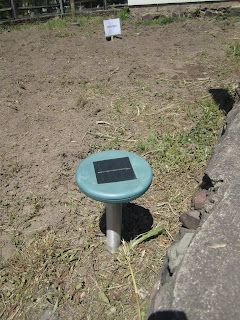The risk inherent in clearing so much land is that a big rain will come along and wash exposed soil into the stormwater drains. That silt-laden runoff then turns the local creek brown and affects the well-being of aquatic life. Standard for this sort of construction site is silt fencing, which is designed to catch the silt before it leaves the site.
Walking by the site a week ago with my raison de marcher--a cairn terrier poodle mix named Leo--I noticed the denuded site was distinctly unswathed, and later emailed the borough engineer, Jack West, who then emailed the county.
A day or two later, the contractor working for Westminster Choir College had the silt fencing in place. It's that black strip in the foreground, with the lower portion partly buried in the ground so that runoff will flow through it rather than underneath it. A pain to install and to remove later on, and only partially effective, silt fencing can easily be "forgotten" during construction.
with additional fabric layed over the stormdrains that lead to Harry's Brook.
Meanwhile, more piping for the underground cistern arrived.
Because there wasn't room for a regular retention basin to catch and hold runoff from the parking lot, rainwater will flow into this underground network of pipes, where it will be retained for awhile to reduce the flashiness of downstream flooding.
Here's what it looks like as of today. During the contentious design process back in the fall of 2009, when the neighbors made the case against installing any new parking lot, I provided some input. If memory serves, the end result of those difficult planning board meetings was a smaller parking lot, with more buffer on the neighbors' side of the field, and less obtrusive lighting. We couldn't talk Westminster Choir College out of spending lots of money on a new lot, but helped them figure out how to use less of the field without sacrificing new parking spaces.
Neighbors had suggested adding spaces on the middle school side of the Westminster property instead of near residences, but a consultant for the Choir College said this field is classified as a wetland. Hopefully, that means it can never be developed.
In addition to being a fine place for kids to run while their older siblings are taking music lessons,
this field recently sprouted the "Westminster Community Garden". Another part of the field would serve well as the safety valve for mega-storm runoff from Walnut Lane and the high school, to prevent future flooding of the performing arts center (see post from August, 2011).










































